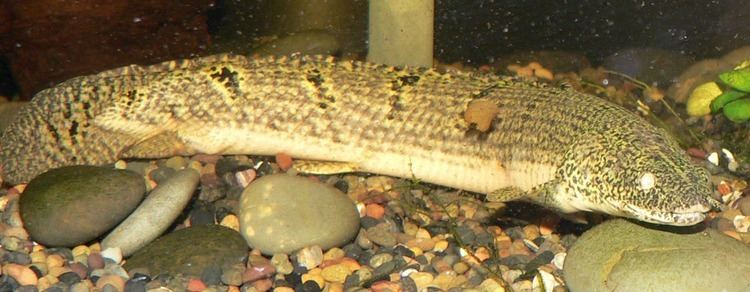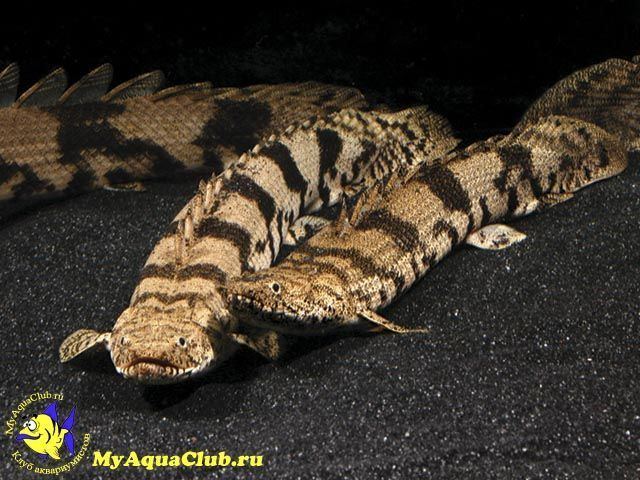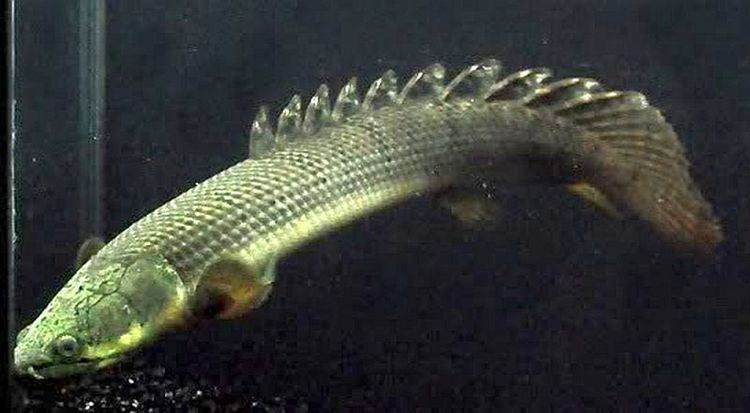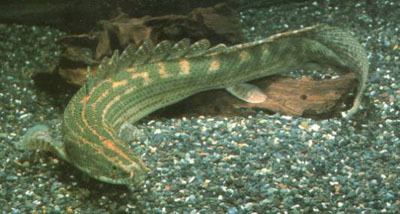Scientific name Polypterus Phylum Chordata Order Bichir | Family Polypteridae Higher classification Bichir Rank Genus Subclass Bichir | |
 | ||
Lower classifications Polypterus senegalus, Polypterus endlicheri endlicheri, Barred bichir, Polypterus ornatipinnis, Polypterus lapradei | ||
All about polypterus senegalus dinosaur bichir fish in the spotlight ep 1
Polypterus is a genus of freshwater fish in the bichir family (Polypteridae) of order Polypteriformes. The type species is the Nile bichir (P. bichir). Fishes in this genus live in various areas in Africa. The etymology of the genus name derives from a combination of the Greek prefix πολυ-, poly- (many) and the root word πτερον, pteron (wing or fin) – "many fins". Polypterus is the only known vertebrate to have lungs, but no trachea.
Contents
- All about polypterus senegalus dinosaur bichir fish in the spotlight ep 1
- Jerry teo polypterus bichir bichir hunting frog
- Recoil aspiration
- Discovery
- Species
- References

Jerry teo polypterus bichir bichir hunting frog
Recoil aspiration

In shallow water, Polypteris inhales primarily through its spiracle (blowhole). Exhalation is powered by muscles in the torso. During exhalation, the bony scales in the upper chest become indented. When the muscles are relaxed, the bony scales spring back into position, generating negative pressure within the torso, resulting in a rapid intake of air through the spiracle. The air is nearly sufficient to fill the lungs. This is followed by one cycle of buccal (mouth) pumping, which "tops off" the lungs, with the surplus air from the buccal pumping process discharged through the pharynx. According to one hypothesis, Devonian tetrapods may have inhaled in this way.
Discovery

Polypterus was discovered, described, and named in 1802 by Étienne Geoffroy Saint-Hilaire. It is a genus of 10 green to yellow-brown species. Naturalists were unsure whether to regard it as a fish or an amphibian. If it were a fish, what type was it: bony, cartilaginous, or lungfish?

Some regarded Polypterus as a living fossil, part of the missing link between fishes and amphibians, helping to show how fish fins had evolved to become paired limbs.

In 1861, Thomas Huxley created the order Crossopterygii to house animals, fossil and living, that possessed lungs and fleshy pectoral fins with lobes. He placed Polypterus and Calamoichthys within this order, allocating them to a new tribe, Polypterini, which he created especially for them. The weight of Huxley’s authority allowed this allocation to last in textbooks and lectures long after it had been disproved.

In the 1870s and 1880s, Francis Balfour and his students had shown that embryology could help to answer questions about the evolution of species. No one had studied the embryology of Polypterus. Someone who could do this might prove the “missing link” theory and be greatly honoured, but it could be a dangerous quest. The only breeding Polypterus specimens were in swampy parts of African rivers. Africa was a turbulent place and swamps were rich breeding grounds for mosquitoes carrying malaria.
Two men, Nathan Harrington and John Samuel Budgett, attempted to answer this question by making repeated expeditions to Africa. Harrington failed on his first attempt in 1898 and died early on his second in 1899 before he could reach his destination. Budgett failed in 1898/9, 1900, and 1902. He finally succeeded in 1903, but died of blackwater fever shortly after his return to England. He left excellent samples and drawings, but his only writing was a diary. Consequently, his results on Polypterus were written up and published by his friend John Graham Kerr.
Drawing on this work, in 1907, E.S.Goodrich reported to the British Association the then current state of evidence 'against' Polypterus being a crossopterygian, placing it within the palaeoniscids, the most primitive actinopterygians.
Much later, in 1946, Romer, confirmed this view, but he also wrote,"The weight of Huxley's [1861] opinion is a heavy one, and even today many a text continues to cite Polypterus as a crossopterygian and it is so described in many a classroom, although students of fish evolution have realized the falsity of this position for many years.... Polypterus...is not a crossopterygian, but an actinopterygian, and hence can tell us nothing about crossopterygian anatomy and embryology." .
Hall (2001), relying on Patterson (1982) and Noack et al. (1996), writes, "Phylogenetic analyses using both morphological and molecular data affirm Polypterus as a living stem actinopterygian." Research is ongoing. Most of the conclusions drawn by Kerr from Budgett’s specimens have been confirmed, but many questions remain.
Polypterus have rarely been bred in captivity. The first success was that of Polypterus senegalus by Arnoult in 1964, a species spawned repeatedly since (see Hartl, 1981; Bartsch and Gemballa, 1992; Bartsch et al., 1997 and Schugardt, 1997).
Shortly after Arnoult’s success, a second species, Polypterus ornatipinnis, was spawned by Armbrust for the first time (1966 and 1973) and bred subsequently by Azuma in 1986; Wolf, 1992; Bartsch and Britz, 1996. The third species successfully spawned in captivity was Polypterus endlicheri by Azuma in 1995.
Zoo Basel have been successful in breeding Polypterus in captivity. In December 2005, several eggs were laid, and at the beginning of 2006, six young had hatched. Within two months, they reached 10 cm (about 4 in).
In 2014 Researchers at McGill University (published in the journal Nature) turned to Polypterus to help show what might have happened when fish first attempted to walk out of the water. The team of researchers raised juvenile Polypterus on land for nearly a year, with an aim to revealing how these 'terrestrialized' fish looked and moved differently. VIDEO:
